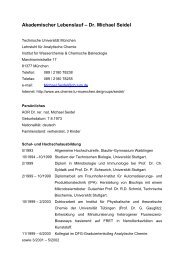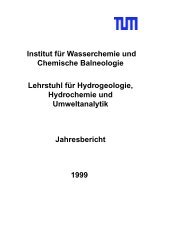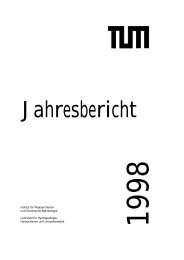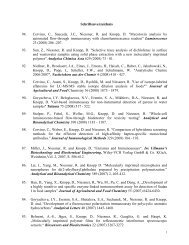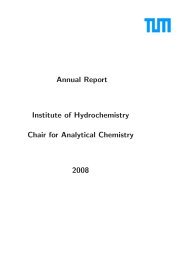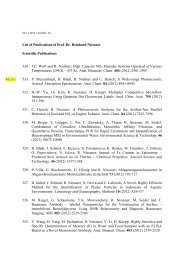IWC Annual Report 2003 - Institut für Wasserchemie und chemische ...
IWC Annual Report 2003 - Institut für Wasserchemie und chemische ...
IWC Annual Report 2003 - Institut für Wasserchemie und chemische ...
Create successful ePaper yourself
Turn your PDF publications into a flip-book with our unique Google optimized e-Paper software.
Eh, V<br />
6<br />
−1.0 −0.5 0.0 0.5 1.0 1.5<br />
1.1.3 Electrochemical Cleanup of Water Treatment Residues<br />
F<strong>und</strong>ing: BayFORREST F179<br />
During the production of drinking water roughly 123.000 t (dry matter) of waterwork<br />
residues acrue each year. Roughly 3/4 of these sludges are disposed and only 1/4 are<br />
reused in other environments. In order to reduce the flux and to avoid accumulation of<br />
enviromentally relevant contaminants, heavy metals and organic contaminants must<br />
not exceed given concentrations.<br />
Cr(OH)2+<br />
Cr(OH)3<br />
Cr(OH)4−<br />
Cr+3<br />
Cr3(OH)4+5<br />
0 2 4 6 8 10 12 14<br />
pH<br />
CrO4−2<br />
CrO4−3<br />
CrOH+2<br />
HCrO4−<br />
Based on the idea of electrochemical soil reclamation,<br />
the purpose of this project was a feasibility study to elaborate<br />
the chemical, mineralogical, and technical conditions<br />
for an electrochemical removal of heavy metal ions and<br />
organic contaminants from waterworks residues. A potential<br />
treatment process should be effective in terms of<br />
flux reduction, treatment time and treatment costs. Of<br />
course, the principal chemical and mineralogical characteristics<br />
of the sludge, which render the sludge useful for<br />
reuse in e.g. sewage treatment plants, must not be altered.<br />
Electrokinetic treatment techniques are generally based<br />
on electrophoresis, electroosmosis and electrochemical processes<br />
at the electrodes. They usually involve a current<br />
source, often filter materials, ion selective membranes, or<br />
specific adsorber materials and sometimes electrolyte solutions<br />
for a better control of the geochemical conditions<br />
in the treated materials. Successful applications include<br />
treatment of contaminated soils, contaminated wood, or<br />
sewage sludge.<br />
In contrast to these, the waterworks residues present a matrix which is rather sensitive<br />
to changes of the pH/Eh conditions. Gibbsite, which is one of the major constituents<br />
of the residue is stable only in the neutral pH range and dissolves at higher<br />
and lower pH values as they occur at the electrodes. Even moderate treatment conditions<br />
and pH-controlling electrolytes led to a quantitative dilution of the sludge. Once<br />
dissolution takes place, the major constituents of the sludge are transported to the<br />
corresponding electrodes and removed from the system. Afterwards the a reformation<br />
of sludge is impossible.<br />
Investigations also showed, that the heavy metal ions rather seem to be integrated<br />
into the Gibbsite flakes than adsorbed to the surface of the sludge. Therefore it seems<br />
impossible to remove the heavy metal ions without a destruction of the matrix.<br />
Given the results of the experiments in the laboratory scale an application of electrochemical<br />
methods to remove heavy metal ions from waterworks residues does not<br />
seem feasible.<br />
(D. Spangenberg)



